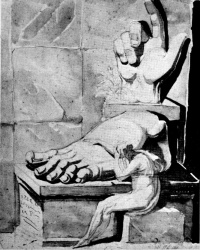Aesthetic universalism
From The Art and Popular Culture Encyclopedia
|
"There are certain effects of colour that give all men pleasure, and others which jar, almost like a musical discord. A more general development of this sensibility would make possible a new abstract art, an art that should deal with colours as music does with sound." --The Sense of Beauty (1896) "Devendra Singh discovered that the most desirable waist–hip ratio was 0.7- a waist that measures 70 percent of the circumference of the hips. An example of a woman who possessed the "perfect" body were Marilyn Monroe."--Sholem Stein |
|
Related e |
|
Featured: |
Aesthetic universalism is a theory that puts forward that humans have universal tastes in beauty and ugliness (aesthetics). It is contrasted by aesthetic relativism, a theory which claims that "de gustibus et coloribus non disputandum est".
Contents |
Beauty in art
The philosopher Denis Dutton has identified seven universal signatures in human aesthetics.
Aesthetic relativists have objected, however, that there are rather too many exceptions to Dutton's categories. For example, the installations of the contemporary artist Thomas Hirschhorn deliberately eschew technical virtuosity. People can appreciate a Renaissance Madonna for aesthetic reasons, but such objects often had (and sometimes still have) specific devotional functions. 'Rules of composition' that might be read into Duchamp's Fountain or John Cage's 4′33″ do not locate the works in a recognizable style (or certainly not a style recognizable at the time of the works' realisation). Moreover, some of Dutton's categories seem too broad: a physicist might entertain hypothetical worlds in his/her imagination in the course of formulating a theory.
Increasingly, academics in both the sciences and the humanities are looking to evolutionary psychology and cognitive science in an effort to understand the connection between psychology and aesthetics. Aside from Dutton, others exploring this realm include Brian Boyd, Joseph Carroll, Nancy Easterlin, David Evans, Jonathan Gottschall, Paul Hernadi, Bracha Ettinger (artist and psychologist), Patrick Hogan, Elaine Scarry, Wendy Steiner, Robert Storey, Frederick Turner, and Mark Turner.
Beauty in nature
The writer Stephen Fry has commented that if we look around us, anything ugly that we see will have been created by human hands; this exemplifies a widely held view that nature is intrinsically beautiful. That the beauty of nature has been celebrated by so large a proportion of our art is further proof of the strength of this association between nature and beauty. Many scientists also share the conviction that nature is beautiful; the French mathematician, Jules Henri Poincaré (1854-1912) said:"The scientist does not study nature because it is useful; he studies it because he delights in it, and he delights in it because it is beautiful.
If nature were not beautiful, it would not be worth knowing, and if nature were not worth knowing, life would not be worth living. Of course I do not here speak of that beauty that strikes the senses, the beauty of quality and appearances; not that I undervalue such beauty, far from it, but it has nothing to do with science; I mean that profounder beauty which comes from the harmonious order of the parts, and which a pure intelligence can grasp."
A common classical idea of beautiful art involves the word mimesis, which can be defined as the perfection and imitation of nature. It is in nature that the perfect is implied through symmetry, equal division, and other perfect mathematical forms and notions. Plato wrote about Socrates and his ideas about how the perfect forms of things exist, and in nature we see the copy of this eternally existing form.
Human need for beauty
|
"If - in the 20th century - beauty was exiled from the arts, it found refuge in advertising, fashion, cinema, product design and consumer culture" --Sholem Stein |
Informed by The Mechanical Bride (1951) and Venus in Exile (2001), it is safe to say that beauty (simple beauty, as in a beautiful woman or man, or a beautiful landscape) had to go somewhere when, during the 20th century, it was banned from the visual arts. The human need for beauty wants to be satisfied and beauty needed a new place to reside. It also needed new patrons, or sponsors as they are called today. Beauty found its new home in consumer culture and cinema, and its new sponsors in Hollywood and the marketing and advertising divisions of consumer good manufacturers.
Further reading
- Venus in Exile (2001) by Wendy Steiner
- The Abuse of Beauty (2003) by Arthur C. Danto
See also
- Aesthetic relativism
- Beauty
- Ugliness
- Golden ratio
- Symmetry
- Female nude
- Sexual selection
- Landscapes and nature
- Universal value



